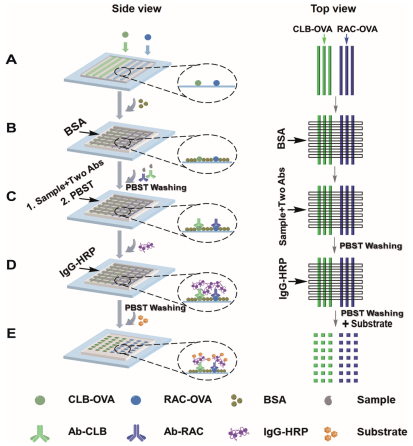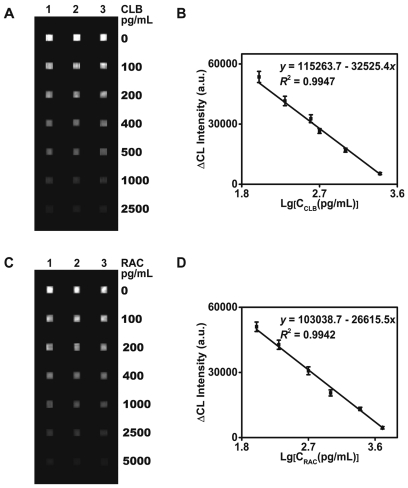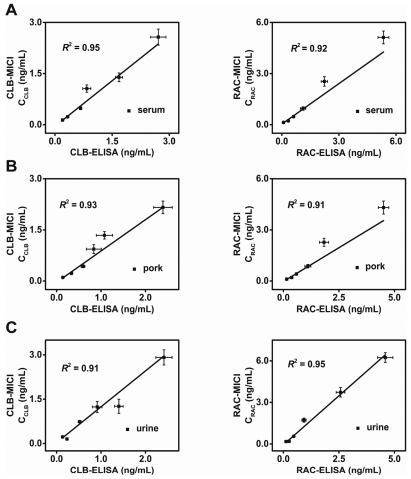
Citation:
Roohan Rakhshaee, Masoud Giahi, Afshin Pourahmad. Removal of methyl orange from aqueous solution by Azolla filicoloides:Synthesis of Fe3O4 nano-particles and its surface modification by the extracted pectin of Azolla[J]. Chinese Chemical Letters,
;2011, 22(4): 501-504.
doi:
10.1016/j.cclet.2010.10.041

-
The modified Fe3O4 nano-particles with the extracted pectin from the cell wall of Azolla filicoloides (FN-EP) can remove methyl orange as a water-soluble azo dye from waste water better than Azolla and the extracted pectin from Azolla (EPA), alone. It could be due to more crowding the main functional groups of uptake after binding pectin with nano-particles. Thermodynamic studies showed that adsorption equilibrium constant (KL) and maximum adsorption capacities (Qmax) were increased with decreasing temperature (exothermic). The maximum uptake capacity (Qmax) of dye by FN-EP in a batch reactor was 0.533, 0.498 and 0.446 mmol/g at 5, 25 and 50℃, respectively. The enthalpy change (△H) and entropy change (△S) were-15.31 kJ/mol and-0.02434 kJ/mol K, respectively.
-
In recent years, vicious incidents of food safety have occurred repetitively, and food safety has become a critical issue. Thus, rapid, sensitive and low-cost detection methods have attracted much attention. Microfluidic chips have shown great prospects in biochemical analysis [1-3]. β-Adrenergic agonists are mainly used to treat bronchial asthma and promote growth of animals [4]. Clenbuterol (CLB) and ractopamine (RAC) are well known β- adrenergic agonists [5]. Because of large dose and long half-life time, β-adrenergic agonists are easy to accumulate in animal tissues [6]. Long-term exposure of residual agonists in visceral tissues and muscles causes poisoning with symptoms of dizziness, chest tightness, palpitations, limb numbness and so on [7, 8]. To ensure food safety, these β-adrenergic agonists have been banned in China, as well as the European Union and Russia [9, 10]. Nowadays, the most widely used instrumental analysis methods for quantitative detection of β-adrenergic agonists are chromatography-based methods, such as high-performance liquid chromatography (HPLC) [11], gas chromatography-mass spectrometry (GC–MS) [12] and liquid chromatography-mass spectrometry (LC– MS) [13, 14], which are used to detect the residues of β-adrenergic agonists in urine, animal tissues and feed. These methods have the advantages of high sensitivity, good accuracy and reproducibility. However, before chromatographic analysis, the samples need be purified through solid-phase extraction or liquid-liquid extraction. Moreover, these expensive instruments are not suitable for the mass screening, where large number of samples need to be examined within a short time-frame [15]. In addition, various techniques, such as fluorescent method [16-18], colorimetric method [19, 20], electrochemical method [21, 22], and electrochemiluminescent method [23, 24], are now available for the determination of trace residue of β-adrenergic agonists. Notably, most of them rely on high-tech instrumentations and professionals. These factors have become main obstacles to broad usage of these methods. Thus, a portable, easy-to-operate and low-cost method for veterinary drug residue detection is urgently needed, especially in resource-limited areas.
In our previous work, we use a variety of microfluidic immunoassays for multiplexed analysis [25-28]. Instruments customized for microfluidic systems can achieve automated detection and data analysis. Herein, we propose a microfluidics-based indirect competitive immunoassay (MICI) system to detect CLB and RAC in real samples simultaneously. The limit of detection (LOD), linear detection range, specificity and recovery rate of MICI are systemically evaluated. The MICI system fully meets the requirements of the national residue detection standards and it is inexpensive and easy to operate. This microfluidic immunoassay system is quite suitable for multiplex detection of veterinary drug residues.
Information about the materials, reagents, apparatus, the microfluidic chip fabrication, analytical procedure and specificity evaluation, as well as sample pretreatment, is included in Supporting information.
The process of simultaneous detection of CLB and RAC includes 5 steps: 1) Immobilization of two kinds of antigen-ovalbumin conjugates (Ag-OVAs) (Fig. 1A). 2) 3% BSA is used to block the surface (Fig. 1B). 3) Competitive immune responses. The introduced targets in sample compete with the previously immobilized Ag-OVAs for the binding site of the antibody (Fig. 1C). 4) The IgGHRP is introduced to react with the antibody (Fig. 1D). 5) Signal generation and readout. After introducing chemiluminescent (CL) substrate, HRP catalyze the reaction between H2O2 and luminol to produce CL signals (Fig. 1E). In this MICI system, the microfluidic technology greatly reduces the consumption of reagents, shortens the reaction time compared to traditional microplate methods, and enables high-throughput, multi-sample simultaneous detection, while sensitivity still can meet the needs for detection of CLB and RAC.
Figure 1
 Figure 1. Scheme of MICI for detection of CLB and RAC. (A) CLB-OVA and RAC-OVA are introduced into the microchannels and immobilized on the PDMS substrates. (B) 3% BSA is used for blocking longitudinally. (C) The targets in sample compete with the coated antigens for the antibody binding sites. (D) Introduction of the second antibodies IgG-HRP. (E) CL substrate is introduced to obtain CL image by the instrument.
Figure 1. Scheme of MICI for detection of CLB and RAC. (A) CLB-OVA and RAC-OVA are introduced into the microchannels and immobilized on the PDMS substrates. (B) 3% BSA is used for blocking longitudinally. (C) The targets in sample compete with the coated antigens for the antibody binding sites. (D) Introduction of the second antibodies IgG-HRP. (E) CL substrate is introduced to obtain CL image by the instrument.We optimize the coating time of the Ag-OVAs. When the coating time is 15 min, the change of ΔCL intensity tends to be stable (Fig. S2B in Supporting information). We optimize the incubation time of the unlabeled antibody. When the incubation time reaches 45 min, the changes of ΔCL intensity are maximized (Fig. S2C in Supporting information). We optimize the incubation time of IgGHRP. When the incubation time reaches 30 min, the ΔCL signal does not change any more (Fig. S2D in Supporting information).
We next investigate the influence of exposure time on the CL signals. When the exposure time is 60 s, the ΔCL intensity of negative samples is close to the maximum value set by the instrument (Figs. S3A and S3B in Supporting information). In order to explore the optimal coating concentrations of clenbuterolovalbumin (CLB-OVA) and ractopamine-ovalbumin (RAC-OVA), we coat Ag-OVAs with different concentrations (5, 10, 20 μg/mL) on the substrate. The CL signal reaches a stable value when the coating concentration is 10 μg/mL (Figs. S4A and S4B in Supporting information). We optimize the concentrations of Ab-CLB and AbRAC. In order to maximize the range of the standard curve and meet the sensitivity requirements, we determine that Ab-CLB with a concentration of 264 μg/mL and Ab-RAC with a concentration of 100 μg/mL are the best choice (Figs. S4C, S4D and S5 in Supporting information). We optimize the concentrations of IgG-HRP and find that the reaction reaches saturation when the concentration of IgG-HRP is 1 μg/mL (Figs. S4E and S4F in Supporting information).
For CLB detection, a calibration curve between ΔCL intensity and the concentration of CLB is obtained with CLB concentration ranging from 100 pg/mL to 2, 500 pg/mL (Figs. 2A and B). For RAC detection, a linear relationship between ΔCL intensity and the concentration of RAC is found for RAC ranging from 100 pg/mL to 5, 000 pg/mL (Figs. 2C and D). The LODs are defined as the concentrations which are equivalent to 10% inhibition concentration (IC10). The LODs of CLB and RAC determined by MICI are 94 pg/mL and 91 pg/mL.
Figure 2
 Figure 2. Calibration curves for the detection of CLB and RAC. (A) The CL image for detection of CLB from 100 pg/mL to 2, 500 pg/mL. (B) Linear range for detection of CLB. (C) The CL signal for detection of RAC range from 100 pg/mL to 5, 000 pg/mL. (D) Linear range for detection of RAC. The error bars represent the standard deviation of six repeats.
Figure 2. Calibration curves for the detection of CLB and RAC. (A) The CL image for detection of CLB from 100 pg/mL to 2, 500 pg/mL. (B) Linear range for detection of CLB. (C) The CL signal for detection of RAC range from 100 pg/mL to 5, 000 pg/mL. (D) Linear range for detection of RAC. The error bars represent the standard deviation of six repeats.The specificity among the Ag-OVAs and their antibodies is evaluated by cross-reactivities (CRs) of Ag-OVAs and antibodies. Apart from CR of the corresponding Ag-OVA and antibody at 100%, the other CRs are calculated using the ratio of ΔCL intensity between the two hybridization signals. For example, CR between CLB-OVA and Ab-RAC is calculated by using Eq. 1.

(1) As shown in Fig. S6A (Supporting information), the CRs are lower than 5% by the calculation, suggesting high specificity of the interaction between the Ag-OVAs and their corresponding antibodies. We evaluate the CRs of antibodies with hapten analogues. As shown in Fig. S6B (Supporting information), only the CLB-spiked PBS solution causes a significant decrease in ΔCL intensity. Similarly, only the RAC-spiked PBS solution results a significant decrease in the ΔCL intensity according to Fig. S6C (Supporting information).
The CRs are calculated by comparing the half maximal inhibitory concentration (IC50) of CLB to those of β-adrenergic agonists in MICI by using Eq. 2.

(2) The data of CRs (Table S3 in Supporting information) further verifies the specificity of the antibody. We can conclude that the specificity of the as-prepared immunoassay system is acceptable and CLB and RAC can be detected simultaneously with this MICI system. We compare the differences of ΔCL intensity and standard calibration curve by introducing only CLB and Ab-CLB or simultaneously introducing two targets and two antibodies (Figs. S7A–C in Supporting information). The results are the same by introducing only Ab-CLB and simultaneously introducing AbCLB and Ab-RAC. We also compare the differences of ΔCL intensity and standard calibration curve by introducing only RAC and AbRAC or simultaneously introducing two targets and two antibodies (Figs. S7D–F in Supporting information). It produces consistent results by introducing only Ab-RAC and simultaneously introducing Ab-RAC and Ab-CLB.
In order to examine the practicability of this system in real samples, the developed MICI is applied in the CLB and RAC detection in negative pork, swine blood and swine urine samples. As shown in Tables S4 and S5 (Supporting information), recovery rates are in the range of 81.2%–108.8%, and the relative standard deviations (RSDs) are all below 15% (six repeated tests are performed in the same experiment), which confirms that the system has excellent accuracy and satisfactory repeatability in real samples. The comparison between MICI and ELISA kits for quantification of both CLB and RAC shows a good agreement (Figs. 3A–C), suggesting that the developed MICI is reliable for the multiple detections of CLB and RAC. So, the developed MICI offers a potential alternative analytical method for the monitoring of CLB and RAC residues in food safety.
Figure 3
We also compare the sensitivity, detection range, analysis time and simultaneous detection with other common detection platforms (Table 1). Our platform is sensitive, fast and has the ability of multiple detection, which is quite suitable for rapid detection of veterinary drug residues.
Table 1
 Table 1. The comparison of the analytical performance of MICI with other platforms for detection of CLB and RAC.
Table 1. The comparison of the analytical performance of MICI with other platforms for detection of CLB and RAC.
In summary, a microfluidics-based indirect competitive immunoassay (MICI) system has been proposed. This method provides a straightforward assay for simultaneous and sensitive detection of CLB and RAC. The results indicate that the system has high stability, sensitivity, acceptable selectivity under optimized experimental conditions. In addition, the portable system is not only easy to operate but also cost effective. Urine, blood and urine samples can be analyzed on site and in real time. These results indicate that the portable microfluidic system is suitable for widespread monitoring of β-adrenergic agonists in pork product, swine blood and swine urine. Moreover, the developed MICI system is easily extended to other analytes by simple replacement of the corresponding antibody, showing great potential as a universal platform for sensitive, high-throughput and specific detection of pollutants in foods.
Declaration of competing interest
The authors declare no conflicts of interest.
Acknowledgments
We thank the National Key R & D Program of China (Nos. 2018YFA0902600, 2017YFA0205901), the National Natural Science Foundation of China (Nos. 21535001, 81730051, 21761142006) and the Chinese Academy of Sciences (Nos. QYZDJ-SSW-SLH039, 121D11KYSB20170026, XDA16020902) for financial support.
Appendix A. Supplementary data
Supplementary material related to this article can be found, in the online version, at doi:https://doi.org/10.1016/j.cclet.2020.01.028.
-

-
-
[1]
Junhua Wang , Xin Lian , Xichuan Cao , Qiao Zhao , Baiyan Li , Xian-He Bu . Dual polarization strategy to enhance CH4 uptake in covalent organic frameworks for coal-bed methane purification. Chinese Chemical Letters, 2024, 35(8): 109180-. doi: 10.1016/j.cclet.2023.109180
-
[2]
Yuwei Liu , Yihui Zhu , Weijian Duan , Yizhuo Yang , Haorui Tuo , Chunhua Feng . Electrocatalytic nitrate reduction on Fe, Fe3O4, and Fe@Fe3O4 cathodes: Elucidating structure-sensitive mechanisms of direct electron versus hydrogen atom transfer. Chinese Chemical Letters, 2025, 36(6): 110347-. doi: 10.1016/j.cclet.2024.110347
-
[3]
Yuan CONG , Yunhao WANG , Wanping LI , Zhicheng ZHANG , Shuo LIU , Huiyuan GUO , Hongyu YUAN , Zhiping ZHOU . Construction and photocatalytic properties toward rhodamine B of CdS/Fe3O4 heterojunction. Chinese Journal of Inorganic Chemistry, 2024, 40(11): 2241-2249. doi: 10.11862/CJIC.20240219
-
[4]
Qinwen Zheng , Xin Liu , Lintao Tian , Yi Zhou , Libing Liao , Guocheng Lv . Mechanism of Fenton catalytic degradation of Rhodamine B induced by microwave and Fe3O4. Chinese Chemical Letters, 2025, 36(4): 109771-. doi: 10.1016/j.cclet.2024.109771
-
[5]
Siyu HOU , Weiyao LI , Jiadong LIU , Fei WANG , Wensi LIU , Jing YANG , Ying ZHANG . Preparation and catalytic performance of magnetic nano iron oxide by oxidation co-precipitation method. Chinese Journal of Inorganic Chemistry, 2024, 40(8): 1577-1582. doi: 10.11862/CJIC.20230469
-
[6]
Xun Zhu , Chenchen Zhang , Yingying Li , Yin Lu , Na Huang , Dawei Wang . Degradation of perfluorooctanoic acid by inductively heated Fenton-like process over the Fe3O4/MIL-101 composite. Chinese Chemical Letters, 2024, 35(12): 109753-. doi: 10.1016/j.cclet.2024.109753
-
[7]
Huyi Yu , Renshu Huang , Qian Liu , Xingfa Chen , Tianqi Yu , Haiquan Wang , Xincheng Liang , Shibin Yin . Te-doped Fe3O4 flower enabling low overpotential cycling of Li-CO2 batteries at high current density. Chinese Journal of Structural Chemistry, 2024, 43(3): 100253-100253. doi: 10.1016/j.cjsc.2024.100253
-
[8]
Gengchen Guo , Tianyu Zhao , Ruichang Sun , Mingzhe Song , Hongyu Liu , Sen Wang , Jingwen Li , Jingbin Zeng . Au-Fe3O4 dumbbell-like nanoparticles based lateral flow immunoassay for colorimetric and photothermal dual-mode detection of SARS-CoV-2 spike protein. Chinese Chemical Letters, 2024, 35(6): 109198-. doi: 10.1016/j.cclet.2023.109198
-
[9]
Gregorio F. Ortiz . Some facets of the Mg/Na3VCr0.5Fe0.5(PO4)3 battery. Chinese Chemical Letters, 2024, 35(10): 109391-. doi: 10.1016/j.cclet.2023.109391
-
[10]
Peng XU , Shasha WANG , Nannan CHEN , Ao WANG , Dongmei YU . Preparation of three-layer magnetic composite Fe3O4@polyacrylic acid@ZiF-8 for efficient removal of malachite green in water. Chinese Journal of Inorganic Chemistry, 2024, 40(3): 544-554. doi: 10.11862/CJIC.20230239
-
[11]
Qiang Li , Jiangbo Fan , Hongkai Mu , Lin Chen , Yongzhen Yang , Shiping Yu . Nucleus-targeting orange-emissive carbon dots delivery adriamycin for enhanced anti-liver cancer therapy. Chinese Chemical Letters, 2024, 35(6): 108947-. doi: 10.1016/j.cclet.2023.108947
-
[12]
Dan Luo , Jinya Tian , Jianqiao Zhou , Xiaodong Chi . Anthracene-bridged "Texas-sized" box for the simultaneous detection and uptake of tryptophan. Chinese Chemical Letters, 2024, 35(9): 109444-. doi: 10.1016/j.cclet.2023.109444
-
[13]
Yu BAI , Jijiang WANG , Long TANG , Erlin YUE , Chao BAI , Xiao WANG , Yuqi ZHANG . A cadmium(Ⅱ) coordination polymer based on a semirigid tetracarboxylate ligand for highly selective detection of Fe3+ and 4-nitrophenol. Chinese Journal of Inorganic Chemistry, 2025, 41(6): 1217-1226. doi: 10.11862/CJIC.20240457
-
[14]
Yuxin Wang , Zhengxuan Song , Yutao Liu , Yang Chen , Jinping Li , Libo Li , Jia Yao . Methyl functionalization of trimesic acid in copper-based metal-organic framework for ammonia colorimetric sensing at high relative humidity. Chinese Chemical Letters, 2024, 35(6): 108779-. doi: 10.1016/j.cclet.2023.108779
-
[15]
Zhi Zhu , Xiaohan Xing , Qi Qi , Wenjing Shen , Hongyue Wu , Dongyi Li , Binrong Li , Jialin Liang , Xu Tang , Jun Zhao , Hongping Li , Pengwei Huo . Fabrication of graphene modified CeO2/g-C3N4 heterostructures for photocatalytic degradation of organic pollutants. Chinese Journal of Structural Chemistry, 2023, 42(12): 100194-100194. doi: 10.1016/j.cjsc.2023.100194
-
[16]
Shiyi WANG , Chaolong CHEN , Xiangjian KONG , Lansun ZHENG , Lasheng LONG . Polynuclear lanthanide compound [Ce4ⅢCe6Ⅳ(μ3-O)4(μ4-O)4(acac)14(CH3O)6]·2CH3OH for the hydroboration of amides to amine. Chinese Journal of Inorganic Chemistry, 2025, 41(1): 88-96. doi: 10.11862/CJIC.20240342
-
[17]
Jijoe Samuel Prabagar , Kumbam Lingeshwar Reddy , Dong-Kwon Lim . Visible-light responsive gold nanoparticle and nano-sized Bi2O3-x sheet heterozygote structure for efficient photocatalytic conversion of N2 to NH3. Chinese Journal of Structural Chemistry, 2025, 44(4): 100564-100564. doi: 10.1016/j.cjsc.2025.100564
-
[18]
Xiao Yu , Dongyue Cui , Mengmeng Wang , Zhaojin Wang , Mengzhu Wang , Deshuang Tu , Vladimir Bregadze , Changsheng Lu , Qiang Zhao , Runfeng Chen , Hong Yan . Boron cluster-based TADF emitter via through-space charge transfer enabling efficient orange-red electroluminescence. Chinese Chemical Letters, 2025, 36(3): 110520-. doi: 10.1016/j.cclet.2024.110520
-
[19]
Haojie Duan , Hejingying Niu , Lina Gan , Xiaodi Duan , Shuo Shi , Li Li . Reinterpret the heterogeneous reaction of α-Fe2O3 and NO2 with 2D-COS: The role of SDS, UV and SO2. Chinese Chemical Letters, 2024, 35(6): 109038-. doi: 10.1016/j.cclet.2023.109038
-
[20]
Cailiang Yue , Nan Sun , Yixing Qiu , Linlin Zhu , Zhiling Du , Fuqiang Liu . A direct Z-scheme 0D α-Fe2O3/TiO2 heterojunction for enhanced photo-Fenton activity with low H2O2 consumption. Chinese Chemical Letters, 2024, 35(12): 109698-. doi: 10.1016/j.cclet.2024.109698
-
[1]
Metrics
- PDF Downloads(0)
- Abstract views(796)
- HTML views(26)

 Login In
Login In




 DownLoad:
DownLoad:

 DownLoad:
DownLoad: